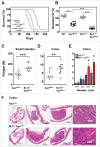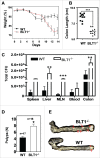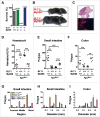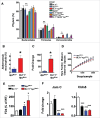Leukotriene B4-receptor-1 mediated host response shapes gut microbiota and controls colon tumor progression
- PMID: 29209564
- PMCID: PMC5706601
- DOI: 10.1080/2162402X.2017.1361593
Leukotriene B4-receptor-1 mediated host response shapes gut microbiota and controls colon tumor progression
Abstract
Inflammation and infection are key promoters of colon cancer but the molecular interplay between these events is largely unknown. Mice deficient in leukotriene B4 receptor1 (BLT1) are protected in inflammatory disease models of arthritis, asthma and atherosclerosis. In this study, we show that BLT1-/- mice when bred onto a spontaneous tumor (ApcMin/+) model displayed an increase in the rate of intestinal tumor development and mortality. A paradoxical increase in inflammation in the tumors from the BLT1-/-ApcMin/+ mice is coincidental with defective host response to infection. Germ-free BLT1-/-ApcMin/+ mice are free from colon tumors that reappeared upon fecal transplantation. Analysis of microbiota showed defective host response in BLT1-/- ApcMin/+ mice reshapes the gut microbiota to promote colon tumor development. The BLT1-/-MyD88-/- double deficient mice are susceptible to lethal neonatal infections. Broad-spectrum antibiotic treatment eliminated neonatal lethality in BLT1-/-MyD88-/- mice and the BLT1-/-MyD88-/-ApcMin+ mice are protected from colon tumor development. These results identify a novel interplay between the Toll-like receptor mediated microbial sensing mechanisms and BLT1-mediated host response in the control of colon tumor development.
Keywords: BLT1; Colon cancer; MyD88; chemokines; host response; inflammation; inflammation and cancer; leukotriene B4; microbiota.
Figures








Similar articles
-
The yin and yang of leukotriene B4 mediated inflammation in cancer.Semin Immunol. 2017 Oct;33:58-64. doi: 10.1016/j.smim.2017.09.005. Epub 2017 Oct 2. Semin Immunol. 2017. PMID: 28982616 Free PMC article. Review.
-
Diesel exhaust particle promotes tumor lung metastasis via the induction of BLT1-mediated neutrophilic lung inflammation.Cytokine. 2018 Nov;111:530-540. doi: 10.1016/j.cyto.2018.05.024. Epub 2018 Jun 5. Cytokine. 2018. PMID: 29884308
-
Leukotriene B4 receptor BLT1 signaling is critical for neutrophil apoptosis and resolution of experimental Lyme arthritis.FASEB J. 2020 Feb;34(2):2840-2852. doi: 10.1096/fj.201902014R. Epub 2019 Dec 24. FASEB J. 2020. PMID: 31908031
-
Targeted disruption of leukotriene B4 receptors BLT1 and BLT2: a critical role for BLT1 in collagen-induced arthritis in mice.J Immunol. 2006 May 15;176(10):6254-61. doi: 10.4049/jimmunol.176.10.6254. J Immunol. 2006. PMID: 16670336
-
LTB4 and BLT1 in inflammatory arthritis.Semin Immunol. 2017 Oct;33:52-57. doi: 10.1016/j.smim.2017.09.009. Semin Immunol. 2017. PMID: 29042029 Review.
Cited by
-
Eicosanoid and Specialized Proresolving Mediator Regulation of Lymphoid Cells.Trends Biochem Sci. 2019 Mar;44(3):214-225. doi: 10.1016/j.tibs.2018.10.007. Epub 2018 Nov 23. Trends Biochem Sci. 2019. PMID: 30477730 Free PMC article. Review.
-
Metabolism pathways of arachidonic acids: mechanisms and potential therapeutic targets.Signal Transduct Target Ther. 2021 Feb 26;6(1):94. doi: 10.1038/s41392-020-00443-w. Signal Transduct Target Ther. 2021. PMID: 33637672 Free PMC article. Review.
-
Mast Cell-Dependent CD8+ T-cell Recruitment Mediates Immune Surveillance of Intestinal Tumors in ApcMin/+ Mice.Cancer Immunol Res. 2018 Mar;6(3):332-347. doi: 10.1158/2326-6066.CIR-17-0424. Epub 2018 Jan 30. Cancer Immunol Res. 2018. PMID: 29382671 Free PMC article.
-
Investigating causality with fecal microbiota transplantation in rodents: applications, recommendations and pitfalls.Gut Microbes. 2021 Jan-Dec;13(1):1941711. doi: 10.1080/19490976.2021.1941711. Gut Microbes. 2021. PMID: 34328058 Free PMC article. Review.
-
Effects of Non-Polar Dietary and Endogenous Lipids on Gut Microbiota Alterations: The Role of Lipidomics.Int J Mol Sci. 2022 Apr 7;23(8):4070. doi: 10.3390/ijms23084070. Int J Mol Sci. 2022. PMID: 35456888 Free PMC article. Review.
References
Publication types
Grants and funding
LinkOut - more resources
Full Text Sources
Other Literature Sources
